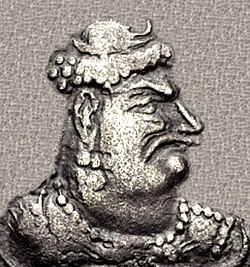
Back Михиракула Bulgarian Mihirakula Catalan Mihirakula German Mihirakula Esperanto Mihiragula French मिहिरकुल Hindi ಮಿಹಿರಗುಲ Kannada മിഹിരകുലൻ Malayalam Mihirakula Polish مہر گل PNB
| Mihirakula | |
|---|---|
| Ruler of the Alchon Huns | |
 | |
| Reign | 515–540 CE |
| Predecessor | Toramana |
| Successor | Toramana II Pravarasena |
| Religion | Shaivism |


 )
)





 ,[1] (Ja)yatu Mihirakula ("Let there be victory to Mihirakula").[2] Rev: Dotted border around Fire altar flanked by attendants in the Sasanian Empire style.[3][4][5]
,[1] (Ja)yatu Mihirakula ("Let there be victory to Mihirakula").[2] Rev: Dotted border around Fire altar flanked by attendants in the Sasanian Empire style.[3][4][5]Mihirakula (Gupta script: ![]()
![]()
![]()
![]()
![]() , Mi-hi-ra-ku-la, Chinese: 摩酰逻矩罗 Mo-hi-lo-kiu-lo), sometimes referred to as Mihiragula or Mahiragula, was the second and last Alchon Hun king of northwestern region of the Indian subcontinent between 502 and 530 CE.[6] He was a son of and successor to Toramana of Huna heritage. His father ruled the Indian part of the Hephthalite Empire. Mihirakula ruled from his capital of Sagala (modern-day Sialkot, Pakistan).[7][8]
, Mi-hi-ra-ku-la, Chinese: 摩酰逻矩罗 Mo-hi-lo-kiu-lo), sometimes referred to as Mihiragula or Mahiragula, was the second and last Alchon Hun king of northwestern region of the Indian subcontinent between 502 and 530 CE.[6] He was a son of and successor to Toramana of Huna heritage. His father ruled the Indian part of the Hephthalite Empire. Mihirakula ruled from his capital of Sagala (modern-day Sialkot, Pakistan).[7][8]
In around 520 CE, the Chinese monk Song Yun met with Mihirakula.[6] According to the 7th-century travelogue of the Chinese Buddhist pilgrim and student Xuanzang, Mihirakula ruled several hundreds of years before his visit, was initially interested in Buddhism, and sought a Buddhist teacher from monasteries in his domain. They did not send him a learned Buddhist scholar. Feeling insulted, he became anti-Buddhist and destroyed the monasteries in his kingdom.[9][10]
Mihirakula is known to have patronized Shaivism tradition of Hinduism.[11] The Rajatarangini calls him cruel, "a man of violent acts and resembling kala (death)", who ruled "the land then overrun by hordes of mlecchas (foreigners)."[12] According to the Chinese Buddhist pilgrim Song Yun, Mihirakula "does not believe in any religion", the Brahmins who live in his kingdom and read their sacred texts do not like him, his people were unhappy.[13]
The Buddhist texts record Mihirakula as extremely cruel and bad mannered,[11][6][14] the one who destroyed Buddhist sites, ruined monasteries, killed monks.[15] The Hindu kings Yashodharman and Gupta Empire rulers, between 525 and 532 CE, likely by 530 CE, reversed Mihirakula's campaign and ended the Mihirakula era.[16][17]
- ^ The "h" (
 ) is an early variant of the Gupta script.
) is an early variant of the Gupta script.
- ^ The "h" (
 ) is an early variant of the Gupta script.
) is an early variant of the Gupta script.
- ^ Verma, Thakur Prasad (2018). The Imperial Maukharis: History of Imperial Maukharis of Kanauj and Harshavardhana (in Hindi). Notion Press. p. 264. ISBN 9781643248813.
- ^ Sircar, D. C. (2008). Studies in Indian Coins. Motilal Banarsidass. p. 376. ISBN 9788120829732.
- ^ Tandon, Pankaj (2013). Notes on the Evolution of Alchon Coins Journal of the Oriental Numismatic Society, No. 216, Summer. Oriental Numismatic Society. pp. 24–34. also Coinindia Alchon Coins (for an exact description of this coin type)
- ^ a b c Grousset, Rene (1970), The Empire of the Steppes, Rutgers University Press, pp. 71–72, ISBN 0-8135-1304-9
- ^ Bakker, Hans (16 July 2014). The World of the Skandapurāṇa. BRILL. ISBN 9789004277144.
- ^ Dani, Ahmad Hasan (1999). History of Civilizations of Central Asia: The crossroads of civilizations: A.D. 250 to 750. Motilal Banarsidass. ISBN 9788120815407.
- ^ Li Rongxi (1996), The Great Tang Dynasty Record of the Western Regions, Bukkyo Dendo Kyokai and Numata Center for Buddhist Translation and Research, Berkeley, pp. 97–100
- ^ Singh, Upinder (2017). Political Violence in Ancient India. Harvard University Press. p. 241. ISBN 978-0-674-97527-9.
- ^ a b Mihirakula, Encyclopaedia Britannica
- ^ Daryaee, T. (2021). King of the Seven Climes: A History of the Ancient Iranian World (3000 BCE - 651 CE). Ancient Iran Series. Brill. pp. 207–208. ISBN 978-90-04-46064-5.
- ^ Chavannes, E. (1903). "VOYAGE DE SONG YUN DANS L'UDYĀNA ET LE GANDHĀRA". Bulletin de l'École française d'Extrême-Orient. 3 (3): 416–417, context:379–441 with footnotes. doi:10.3406/befeo.1903.1235. JSTOR 43729722.
- ^ Behrendt, Kurt A. (2004). Handbuch der Orientalistik. BRILL. ISBN 9789004135956.
- ^ A. L. Basham (1967). The Wonder That Was India. Public Resource.
- ^ Cite error: The named reference
Sagarwas invoked but never defined (see the help page). - ^ Cite error: The named reference
Majumdar1977p242was invoked but never defined (see the help page).